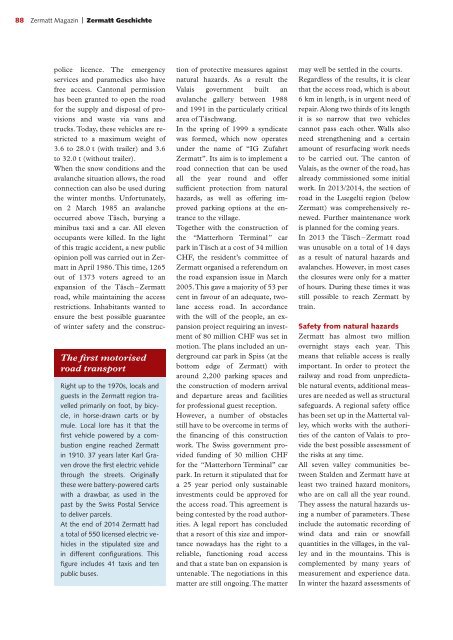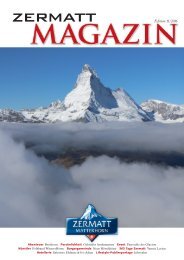Zermatt Magazin 2015
Zermatt Magazin 2015
Zermatt Magazin 2015
Erfolgreiche ePaper selbst erstellen
Machen Sie aus Ihren PDF Publikationen ein blätterbares Flipbook mit unserer einzigartigen Google optimierten e-Paper Software.
88 <strong>Zermatt</strong> <strong>Magazin</strong> | <strong>Zermatt</strong> Geschichte<br />
The first motorised<br />
road transport<br />
Right up to the 1970s, locals and<br />
guests in the <strong>Zermatt</strong> region travelled<br />
primarily on foot, by bicycle,<br />
in horse-drawn carts or by<br />
mule. Local lore has it that the<br />
first vehicle powered by a combustion<br />
engine reached <strong>Zermatt</strong><br />
in 1910. 37 years later Karl Graven<br />
drove the first electric vehicle<br />
through the streets. Originally<br />
these were battery-powered carts<br />
with a drawbar, as used in the<br />
past by the Swiss Postal Service<br />
to deliver parcels.<br />
At the end of 2014 <strong>Zermatt</strong> had<br />
a total of 550 licensed electric vehicles<br />
in the stipulated size and<br />
in different configurations. This<br />
figure includes 41 taxis and ten<br />
public buses.<br />
police licence. The emergency<br />
services and paramedics also have<br />
free access. Cantonal permission<br />
has been granted to open the road<br />
for the supply and disposal of provisions<br />
and waste via vans and<br />
trucks. Today, these vehicles are restricted<br />
to a maximum weight of<br />
3.6 to 28.0 t (with trailer) and 3.6<br />
to 32.0 t (without trailer).<br />
When the snow conditions and the<br />
avalanche situation allows, the road<br />
connection can also be used during<br />
the winter months. Unfortunately,<br />
on 2 March 1985 an avalanche<br />
occurred above Täsch, burying a<br />
minibus taxi and a car. All eleven<br />
occupants were killed. In the light<br />
of this tragic accident, a new public<br />
opinion poll was carried out in <strong>Zermatt</strong><br />
in April 1986. This time, 1265<br />
out of 1373 voters agreed to an<br />
expansion of the Täsch – <strong>Zermatt</strong><br />
road, while maintaining the access<br />
restrictions. Inhabitants wanted to<br />
ensure the best possible guarantee<br />
of winter safety and the construction<br />
of protective measures against<br />
natural hazards. As a result the<br />
Valais government built an<br />
avalanche gallery between 1988<br />
and 1991 in the particularly critical<br />
area of Täschwang.<br />
In the spring of 1999 a syndicate<br />
was formed, which now operates<br />
under the name of “IG Zufahrt<br />
<strong>Zermatt</strong>”. Its aim is to implement a<br />
road connection that can be used<br />
all the year round and offer<br />
sufficient protection from natural<br />
hazards, as well as offering improved<br />
parking options at the entrance<br />
to the village.<br />
Together with the construction of<br />
the “Matterhorn Terminal” car<br />
park in Täsch at a cost of 34 million<br />
CHF, the resident’s committee of<br />
<strong>Zermatt</strong> organised a referendum on<br />
the road expansion issue in March<br />
2005. This gave a majority of 53 per<br />
cent in favour of an adequate, twolane<br />
access road. In accordance<br />
with the will of the people, an expansion<br />
project requiring an investment<br />
of 80 million CHF was set in<br />
motion. The plans included an underground<br />
car park in Spiss (at the<br />
bottom edge of <strong>Zermatt</strong>) with<br />
around 2,200 parking spaces and<br />
the construction of modern arrival<br />
and departure areas and facilities<br />
for professional guest reception.<br />
However, a number of obstacles<br />
still have to be overcome in terms of<br />
the financing of this construction<br />
work. The Swiss government provided<br />
funding of 30 million CHF<br />
for the “Matterhorn Terminal” car<br />
park. In return it stipulated that for<br />
a 25 year period only sustainable<br />
investments could be approved for<br />
the access road. This agreement is<br />
being contested by the road authorities.<br />
A legal report has concluded<br />
that a resort of this size and importance<br />
nowadays has the right to a<br />
reliable, functioning road access<br />
and that a state ban on expansion is<br />
untenable. The negotiations in this<br />
matter are still ongoing. The matter<br />
may well be settled in the courts.<br />
Regardless of the results, it is clear<br />
that the access road, which is about<br />
6 km in length, is in urgent need of<br />
repair. Along two thirds of its length<br />
it is so narrow that two vehicles<br />
cannot pass each other. Walls also<br />
need strengthening and a certain<br />
amount of resurfacing work needs<br />
to be carried out. The canton of<br />
Valais, as the owner of the road, has<br />
already commissioned some initial<br />
work. In 2013/2014, the section of<br />
road in the Luegelti region (below<br />
<strong>Zermatt</strong>) was comprehensively renewed.<br />
Further maintenance work<br />
is planned for the coming years.<br />
In 2013 the Täsch – <strong>Zermatt</strong> road<br />
was unusable on a total of 14 days<br />
as a result of natural hazards and<br />
avalanches. However, in most cases<br />
the closures were only for a matter<br />
of hours. During these times it was<br />
still possible to reach <strong>Zermatt</strong> by<br />
train.<br />
Safety from natural hazards<br />
<strong>Zermatt</strong> has almost two million<br />
overnight stays each year. This<br />
means that reliable access is really<br />
important. In order to protect the<br />
railway and road from unpredictable<br />
natural events, additional measures<br />
are needed as well as structural<br />
safeguards. A regional safety office<br />
has been set up in the Mattertal valley,<br />
which works with the authorities<br />
of the canton of Valais to provide<br />
the best possible assessment of<br />
the risks at any time.<br />
All seven valley communities between<br />
Stalden and <strong>Zermatt</strong> have at<br />
least two trained hazard monitors,<br />
who are on call all the year round.<br />
They assess the natural hazards using<br />
a number of parameters. These<br />
include the automatic recording of<br />
wind data and rain or snowfall<br />
quantities in the villages, in the valley<br />
and in the mountains. This is<br />
complemented by many years of<br />
measurement and experience data.<br />
In winter the hazard assessments of







